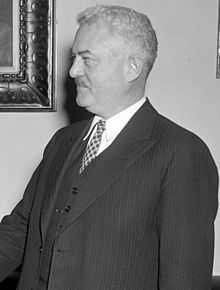Frank H. Buck
| Frank H. Buck | |
|---|---|
 | |
| Member of the U.S. House of Representatives from California's 3rd district | |
| In office March 4, 1933 – September 17, 1942 | |
| Preceded by | Charles F. Curry, Jr. |
| Succeeded by | Justin L. Johnson |
| Personal details | |
| Born | September 23, 1887 Vacaville, California |
| Died | September 17, 1942 (aged 54) Washington, D.C. |
| Political party | Democratic |
| Spouse(s) | Zayda Zabriskie Eva M. Benson |
| Children | 4 |
Frank Henry Buck (September 23, 1887 – September 17, 1942) was an American heir, businessman and politician. He served as U.S. Representative from California from 1933 to 1942.
Biography
Early life
Frank Buck was born on a ranch near Vacaville, California on September 23, 1887.[1][2] His grandfather, Leonard W. Buck, was the founder of the Buck Company, a fruit-growing company, who had been elected to the California State Senate in 1895.[2] He attended the public schools.[1] He graduated from the University of California at Berkeley in 1908 and from the law department of Harvard University in 1911.[1][2] He was admitted to the bar the same year and commenced practice in San Francisco, California.[1][2]
Business
He was involved in business ventures including fruit growing, oil refining, and lumber, partly thanks to his inheritance.[1][2]
In 1900, together with Burton E. Green (1868-1965), Charles A. Canfield (1848-1913), Max Whittier (1867–1928), William F. Herrin (1854-1927), Henry E. Huntington (1850-1927), William G. Kerckhoff (1856–1929), W.S. Porter and Frank H. Balch, known as the Amalgated Oil Company, he purchased Rancho Rodeo de las Aguas from Henry Hammel and Andrew H. Denker and renamed it Morocco Junction.[3] After drilling for oil and only finding water, they reorganized their business into the Rodeo Land and Water Company to develop a new residential town later known as Beverly Hills, California.[3]
He became the leader of the newly founded California Grower's and Shipper's Protective League, a lobbying organization to protect the rights of fruit and vegetable growers.[2] In 1933, he sold the Buck Company, his grandfather's company, to the Pacific Fruit Exchange.[2]
Politics
He served as delegate to the Democratic National Conventions in 1928, 1936, and 1940.[1] In 1933, he was elected as a Democrat to the U.S. House of Representatives.[1] He served in Congress from March 4, 1933 until his death in Washington, D.C. on September 17, 1942.[1] He is credited with naming the Social Security program.[4]
Personal life
He married Zayda Zabriskie in 1911 and they had four children.[2] After they divorced, he married Eva M. Benson in 1926.[2] He died on September 17, 1942.[2] He was interred in Vacaville-Elmira Cemetery, in Vacaville, California.[1][2] His wife, Eva B. Buck, founded the Frank H. Buck scholarship, which is awarded each year to 8 to 16 high school seniors, who have to live in his former congressional district.[2]
References
| United States House of Representatives | ||
|---|---|---|
| Preceded by Charles F. Curry, Jr. |
Member of the U.S. House of Representatives from California's 3rd congressional district 1933–1942 |
Succeeded by Justin L. Johnson |
![]() This article incorporates public domain material from websites or documents of the Biographical Directory of the United States Congress.
This article incorporates public domain material from websites or documents of the Biographical Directory of the United States Congress.